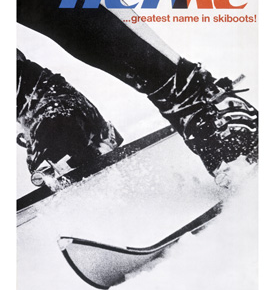
At first a gimmicky convenience, the boot buckle took ten years to earn its place among the sport’s enduring inventions.
In 1955 a former stunt pilot and Swiss inventor named Hans Martin sold the world’s leading ski boot company, Henke, his patent for using metal buckles rather than laces to fasten leather boots.
Skiers needed such a convenience. The number of lacing hooks and eyelets on a pair of boots had skyrocketed to as many as 90 with the introduction around 1950 of the inner boot and rear lacing. The digitally challenged skier could now spend as long as 10 minutes lacing the equivalent of four boots before setting out on the slopes, to say nothing of fine-tuned re-lacing adjustments during the day. Time wasn’t the only inconvenience. Tightening the laces of the hard, stiff outer boot, unless you used a hook-like device to draw them taut, caused raw, sore fingers. And pity the racer who attempted to adjust his laces on a raw frigid January day before stepping into the starting gate. It was an experience comparable to that possibly felt by Scott penciling his dying thoughts in Antarctica.
The buckle boot surely would be the answer. “No more frozen fingers!” claimed Henke. “Flip it open. . .flip it shut. Keep your gloves on!” But when Henke’s salesmen began to show their $49.50 Speedfit boot to dealers in the 1955, they were often laughed out of the shops. At the time buckles were associated with the galoshes worn by folks to walk through slushy streets. “Who would want to wear galoshes to ski?” sneered skeptical shop owners.
Nor did skiers invade shops demanding the revolutionary lace-less boot. They were reluctant to give up lacing’s comfortable close fit, especially when the hard outer boot contained a soft separately laced inner boot. The infinite adjustability offered skiers the most personalized fit they would enjoy until the arrival of custom-foamed liners 20 years later. By contrast, buckles created stresses and painful pressure points on the foot where they attached to the leather.
Racers — usually the first to seize on new technology — didn’t begin to adopt the buckle boot until the early 1960s when other bootmakers improved on Martin’s original design, and offered hand-lasted inners and better-designed tongues to even out the pressure. Even then, a top racer would wear out a boot in a few weeks as the leather stretched beyond repair. What the performance-oriented skier awaited was leather’s replacement by indestructible, stiffer plastic. In Dubuque, Iowa, plastic boot inventor Bob Lange made his early prototypes using laces, but it was almost humanly impossible to cinch tight the hard, unpliable plastic. Only buckles, Lange discovered in 1965, would enable his new boot to work. Fortunately for him, the buckle had already been invented. . . and the design and making of ski boots changed forever.
Heinz Herzog, long-time president of Raichle-Molitor USA, adds this comment:
It was not uncommon to suffer frostbite as a result of wearing seamed leather boots without interior padding or insulation. To cinch a long thong around the boot, I remember having to thread it through a couple of steel rings with bare fingers. Hans Martin, a Swiss, invented the buckle. Part of his patent covered the method of mounting each buckle on the boot, a challenge because it was leather. Need to spread pressure, not create pressure points. Martin sold the patent to the Swiss boot company, Henke. Others tried to design their own, but Martin’s design was the only one that worked, so the other boot companies like Molitor paid Henke for the right to use the Martin-designed buckle. Le Trappeur had the greatest success in racing. Instead of having the two buckles going laterally across the shaft, they attached one diagonally at the heel.
Martin spent tens of thousands trying to make a one-buckle boot.


